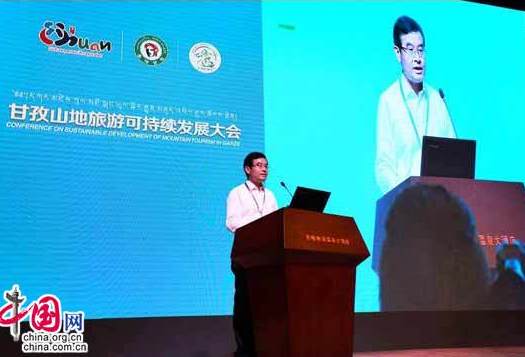
Ganzi vigorously develops mountain tourism

Fifteen to twenty percent of the world’s tourism?revenues comes from mountain tourism, said Hao Kangli, Director of the Sichuan Tourism Board, Wednesday afternoon.
Hao mentioned the figure when addressing a conference on the sustainable development of mountain tourism in Ganzi prefecture, Sichuan. The event is part of the ongoing 2016 Sichuan Ganzi Mountain Tourism Festival.
Mountains in Sichuan enjoy great fame both at home and abroad for being awe-inspiring, fascinating, dangerous, unique, and culturally rich. With this advantage, Sichuan is developing mountain tourism into a new pillar of its tourism industry, said Hao.
While developing mountain tourism vigorously, Sichuan and Ganzi should keep the bottom line of not damaging the ecological system; only in this way can they achieve sustainable development, said Hao.??
Local governments must no longer willfully develop their mountains at all costs, but instead protect them, said Hao, urging for strict protection for mountain landscape and environment and better integration of tourism development, ecological conservation and cultural inheritance.
As the tourism industry in China is undergoing a shift from being scenic spot-based to being region-based, Ganzi is closely following the trend.
“Ganzi will firmly develop region-based tourism,” said Hao. “The prefecture will methodically plan and build infrastructure, design public service and develop its towns and villages; it will give preference to the tourism industry in terms of policies, projects, funds and human resources in order to improve the tourism factors and services.”
Boasting many world-class tourism resources, Ganzi is like an idyllic scroll painting. National Road G318, the most scenic drive in China, runs through it. Other famous scenic areas include snow-capped Mount Gongga, Daocheng Yading (praised as the last land of pure beauty), and Jiaju Tibetan Village.
On the strength of its unique mountain culture, the prefecture is creating a number of regional-level and national-level mountain tourism destinations encompassed in a “1+6+N” system. One means one groups of relics parks along the scenic 318/317 national roads; six means six characteristic tourism destinations including one resort for sports and vacation around Mount Gongga; N means a large number of scenic areas and self-driving camps.
Ganzi is also actively cooperating with institutions of higher education and tourism organizations in the Asia-Pacific region to foster high-caliber and high-standard human resources with an international vision, Hao said.
Ganzi is also relying on tourism development for poverty alleviation.
“Ganzi still faces a massive task of lifting itself out of poverty. It is counting on the three approaches of making scenic areas to drive local development, developing rural tourism and marketing tourism goods to solve the problem,” Hao said.
“It aims to?make its mountains?a source of fame and revenue instead of?a cause for?poverty as they used to be.”
“We hope that in the future, the world will look to China, especially Sichuan and Ganzi when it comes to mountain tourism,” said Hao.








